Disclaimer: This review is very outdated. Dead Space 2 has been available since October of last year (give or take). I wasn’t able to finish it until recently because of technical difficulties with my PS3, and then Dead Space 2 got pushed back behind other games.
Disclaimer 2: I played this game on the “Survivalist” (hard) setting. I did this because the first Dead Space game was kind of easy (except for the stupid asteroid-shooting part), and I was able to coast through most of it with just the Plasma Cutter and Line Gun. I was hoping that on a harder difficulty, Dead Space 2 would force me to be creative on my feet and have to use some of the cooler abilities like kinesis, stasis, and the environment. For the first few chapters, that worked fairly well. But about halfway through, it started becoming frustratingly hard and never evened out.
I really like reviewing stuff long after it’s been released. I don’t feel as much pressure to avoid spoilers because I know everybody who cares enough has already played it. So I feel more free to go deeper into the analysis and talk about the tings that I can’t talk about if I’m afraid of ruining a surprise.
Back in that “gaming sweet spot”?
The first Dead Space really impressed me. A lot. I think it was released in the same year as Grand Theft Auto IV and Metal Gear Solid 4. And Dead Space ended up being my favorite game of that year. Of course, part of that was because I was actually able to finish Dead Space by the end of the year, and Grand Theft Auto took longer. In hindsight, GTA IV was probably better. The first Dead Space game perfectly captured the feel of the classic science fiction horror film Alien, but with a bit more action.
The attention to detail was astounding, and the Ishimura just felt so functional! Like a real spaceship. Other than the artificial gravity, the Ishimura seemed like something you might see on a Science Channel special about hypothetical space mining craft The layout and organization of the ship just made sense, and the use of holographic displays as the game’s HUD and interface was brilliant design. And the space setting made the clunkiness of the character's movements actually work thematically - even though he still performed better than the characters from Resident Evil 4 and 5 anyway!
The concept of dismembering enemies to kill them was novel and added a unique dynamic to the otherwise stale shooter formula. On top of that, every one of the improvised engineering tools that were offered as weapons kicked ass (only, ironically, the military pulse rifle felt weak). And the boot stomp! Oh, the boot stomp!
Dead Space hit a gaming sweet spot for me that would be very difficult to improve upon in a sequel. Everything about it just felt so right – except that asteroid shooter segment – that part blew big time.
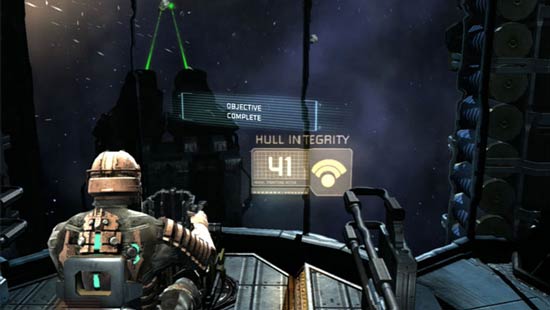
The dreaded asteroid shooting segment from the first Dead Space that comes dangerously close to ruining the whole game!
Dead Space 2 just doesn’t maintain that feeling of rightness. And it wasn’t just that I was playing on a harder difficulty, either. Many elements of the design just don’t stand up to my memory of the first game.
There are a few improvements to the formula, but they are minor. The visuals have been upgraded and dynamic lighting has been added. There’s some new weapons, and they each have their uses. Only the Javelin Gun stood out, but I ditched it in favor of the Force Gun and Contact Beam as soon as I could. I still stuck with the Plasma Cutter and Line Gun throughout most of the game.
The objective marker (triggered by clicking the right stick) can now be toggled between pointing you to your next objective, or the nearest save station, bench, or store. This is a handy new feature, but it feels like a give and take, since the developers decided to take away the mini-map from the menu for whatever reason. I guess the lack of a map makes more thematic sense, but I would think that Isaac’s rig can tell me where my next objective or store is, then it should be able to sync up to the station and give me a full map.
I was also impressed with some of the texture work during the delusion scenes. The walls seem to come alive with moving symbols and images, and it looks pretty neat if you take the time to look at it between getting raped by necromorphs. It would also be more impressive if Silent Hill 3 hadn’t already done that on the last generation of systems 7 years ago. But hey, I guess if I’m comparing a horror game to Silent Hill 3, then the game must be doing something right.
| Moving wall textures are cool, but it's been done already. |
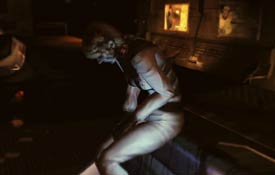
Hallucination scene in Dead Space 2. |
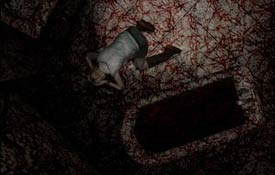
The otherworld invading the real world in Silent Hill 3. |
But beyond that, the game really didn’t do it for me.
You add one new game mechanic and don’t even get it right?
One of the big selling-points of this game is the new zero-gravity controls. It seems like an awesome idea and a perfect addition to the space horror gameplay formula. But Visceral managed to completely botch this mechanic. They gave the player control of only two axis of movement. You can move in the Z and X direction as well as pitch and yaw. But you have no control of movement along the Y axis or any control over the character’s roll. So you can’t “strafe up” or “strafe down” to attack enemies around a corner that’s above or below you. You have to either turn sideways or just rotate yourself to go up over the corner and rotate back down to face the enemy. If you’re going to give us a 3-dimensional shooter, then you need to give us a 3-dimentional strafe!
You also can’t toggle zero-g mode when using kinesis or when a weapon is drawn, nor can you align to the ground when using kinesis in zero-g.
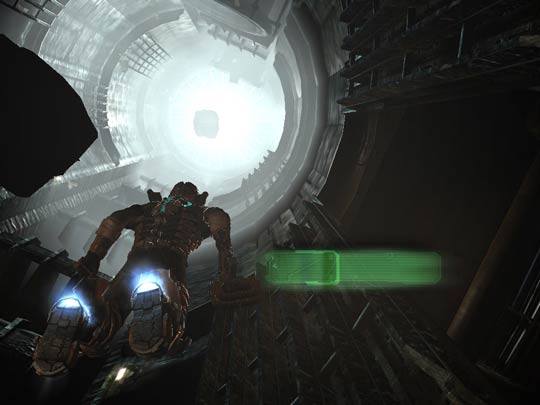
Zero-g gameplay in Dead Space 2. Better hope there isn't a bad guy on that ledge in front of you, because you can't just "float" upward to strafe to it.
Boss battles also weren’t horribly improved. And by "not horribly improved", I mean "they weren't improved at all". They all seem to be the same thing. You run around in circles from a giant monster that just leaps at you and knocks you down. If it misses, then you turn around and use statis, then shoot it’s weak spots. There’s no look back camera, so you can’t see where the giant monster is while you’re running around in circles, except when it knocks you over.
There’s a few set piece “boss” encounters, and they’re OK, but no better than other games.
I guess I’m just not as good as I thought…
About halfway through the game, things started getting really rough. It was on the hard setting, so I expected some challenge. But I just didn’t feel like the challenge was fair. The game is very dark. You get a flashlight. But it makes practically no difference. The light is weak and made it incredibly hard to find items that you can use to kinesis the enemies. Finding kinesis-able items would be nice when you’re out of ammo. Which happens on the hard difficulty setting.
The latter chapters of the game are designed to shove you into confined spaces or platforms with hordes of enemies coming from all around you, climbing over rails or dropping from the ceiling. This goes on consistently for at least 5 chapters or so. What’s worse, sometimes when you kill the enemies in these areas, they fall off a ledge into a bottomless pit, and you don’t even get the sparkle-sparkle reward pickups that they drop. That’s bad design. The levels are specifically designed to compound the problem of ammunition limitation and force the player to put himself in a vulnerable position by allowing the enemy to get closer before you kill it (to avoid pushing it off a ledge).
I guess this is where I differ from other people when it comes to horror in video games.
At some point, the merciless hordes of enemies stop being scary and just start to get frustrating and annoying. The constant loading screens putting you right back in front of the door to the room you just died in get boring to look at. You just start cruising on automatic, replaying the same room over and over again until you get it perfect through trial-and-error or you strike a lucky break. It’s not fun anymore. It’s like the trial-and-error games of the 8 and 16-bit eras, except that you don’t have to go all the way back to the start of the whole game when you die.
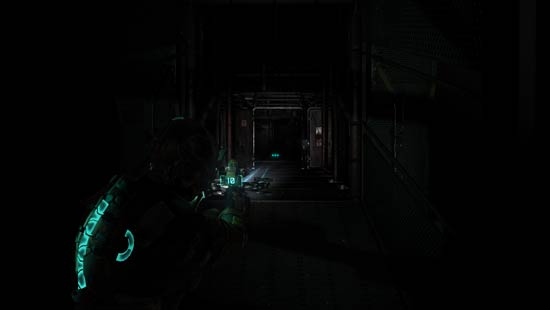
Get used to your visibility being this bad (or worse). Now, imagine there are small monsters crawling along the floor and coming at you from all angles. You won't see them coming, and when they grab you, it will feel cheap...
I don’t mind a challenge from a game. As long as it’s a fair challenge. A game like Demon’s Souls I can appreciate. It’s brutally difficult. But it does so without feeling cheap or repetitive. If you die, it’s because you screwed up. Not because the game spawned an enemy right behind you, or put you in a position where you can’t fight back, or threw more enemies at you than the game’s controls and mechanics can possibly let you defend against. Eventually in Demon’s Souls, I got to the point where I could clear entire stages without dying. Because the repeated deaths in the first sections taught me how to play better. They taught me how to be cautious. They improved my technique. And the need for that caution created fear. Demon’s Souls is a scary game! Much scarier than Dead Space 2. And it doesn’t rely on zombie Dobermans jumping through the window at you, or a corpse suddenly reanimating itself, or stuffing you on a 15 foot by 15 foot elevator with monsters literally falling out of the sky like a 1992 arcade beat-em-up.
Horror, for me, comes from the constant build-up of anxiety and tension over the course of hours of gameplay. The first few Resident Evil games, Silent Hill 2 and 3, Fatal Frame, and Demon's Souls succeeded tremendously in these departments. Yes, combat in Resident Evil and Silent Hill 2 was almost trivial. The enemies were more of an inconvenience rather than a real threat. But wandering around the creepy environments for hours of gameplay, uninterrupted by character deaths and checkpoint respawns, allowed a sense of immersion to build over time.
But when you get to the point where every room is full of monsters, and you're restarting from checkpoints on a regular basis, the horror is lost. It becomes less like a horror movie or genuine survival situation, and starts to feel like an 8 or 16-bit trial-and-error side scroller that mercifully doesn't send you all the way back to the start of the game every time you die. And if I feel more inclined to compare a modern horror game to the original Castlevania instead of Resident Evil or Silent Hill, then there is something wrong. Thank you Resident Evil 4 for starting a precedent that set game design philosophies back 20 years!
Yes, in the old games, you were partly afraid of suffering a cheap death and having to lose large chunks of game time (sometimes whole hours). That was irritating. But having to replay the same hour or two of a game once is infinitely preferrable to playing the same 10-minute room over and over again for an hour or two. And then repeating that at regular intervals.
Did the designers that made Visceral successful bail during Dante’s Inferno?
I heard that some of the big-time designers from Visceral left the studio halfway through the development of Dante’s Inferno. I don’t know if this is true. I tried looking it up, but couldn’t confirm it. If someone can find a link confirming or denying this, please post it in the comments. But given the decline in quality from the second half of Dante’s Inferno and the way that Dead Space 2 turned out, I would not be surprised. It just seems like all the design elements that made the first game successful and good are missing from the sequel or just phoned in without improvement or refinement.
First of all, Titan Station is a piss-poor replacement for the Ishimura. The Ishimura felt so real. It contained so much atmosphere and personality. The space station has no personality. It didn’t really feel like a single, unified, cohesive place. More like a collection of random places. One minute, you’re in a mall concourse , the next is a church, then a day care center, then the guts of the space station. It provides a lot of visual variety, but it just doesn’t flow very well.
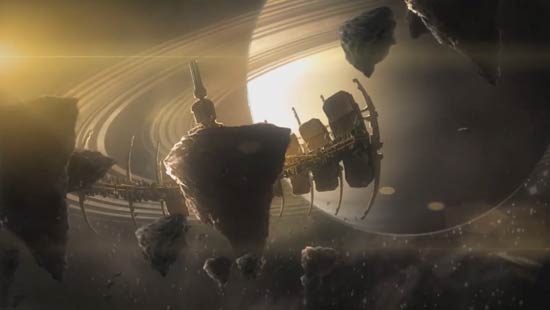
The Sprawl on Titan Station provides a few pretty Saturn backdrops, but is mostly forgettable.
And the fact that Isaac’s primary method of getting from place to place was by being thrown across the station by enemy monsters or mechanical malfunctions didn’t help smooth the transitions or make the station feel more alive. The tram system in the first game not only provided a believably elegant mechanism for transportation across the game's various "levels", but also provided natural breaking points for the chapter divisions. In the sequel, I often felt like my progress through the station was completely random and arbitrary by comparision.
Apparently, in the Dead Space universe, mankind has the technology and knowledge to create faster-than-light travel, artificial gravity, and holographic computer interfaces, but they don’t know to use bullet-proof glass or transparent plastic for their space station windows? And if that weren’t bad enough, the emergency bulkhead trigger is a glowing, diamond-shaped switch on the ceiling over the window, and you have to shoot it to close the bulkhead. Why wouldn’t it be on the ground? Or on the wall? Or some other place where a person could reach it before being blown out into space? Or better yet, why doesn’t the bulkhead lower automatically upon decompression?
Also, what’s with all those metal rods with dim, white lights on one end that are just sitting around? What are they for? What do they do? You know, other than impaling necromorphs…
The first game just had a much better balance between challenging enemy encounters, puzzles, creepy atmosphere, and paranoia. The sequel seems to too heavily rely on jump-out-at-you scares and overwhelming you with bad guys to add challenge to the game. The excessive darkness doesn’t make the game scarier. It just makes it hard to see what the heck is going on. Sometimes, I can’t even see what’s happening to my own character. I’ll be pressing a button trying to shoot something coming at me, only to realize a few seconds later that another necromorph had already grappled me, but I didn't notice it because it's so dark I couldn't even see my own character flailing his arms around. The first game didn’t need to put you in pitch black to scare you, and it used technically inferior ambient lighting, shadows, and colors to much greater atmospheric and creepy success. Darkness only works if it contributes to the gameplay, rather than hindering it.
Some people complained about Isaac being mute and faceless in the first game. But giving the main character a face and a voice is not an improvement. The voiceless, faceless protagonist of the first game allowed the player to project their own personality and experience onto him. He wasn’t just a mute errand-boy doing whatever other people told him. He was you (and you’re a mute errand-boy doing whatever other people tell you). It didn’t matter that his lack of personality and a voice made it hard to relate to him. You didn’t need to “relate to him”. He was you. Giving him a voice and face and personality just creates an extra level of separation between the events in the game and the player. And that takes away some of the tension and horror.
The plot revolves around Isaac having dementia and seeing images of his dead girlfriend Nicole. She guides him through the station, making him think that she’s going to guide him to destroying the marker. And then she backstabs him, and it turns out she was a delusion created by the marker to lure Isaac to it.
Hey, isn’t that the same plot as the first game? Yeah, it is, isn't it? They add some stuff about government conspiracies, and a few minor details about the Unitology religion. But they don’t really add anything to the Dead Space mythos.
The stuff they got right
It’s not all bad. There are a few very short-lived segment of the game that really impressed me:
- Going into the Galilei train station in Chapter 1 (after clearing the apartments) and seeing the hallucination of Nicole turn into a flaming subway car. That was pretty cool!
- The beginning of Chapter 10, when you revisit the Ishimura. Here, the developers allow you to traverse the abandoned corridors of the ship undergoing remodeling. Flickering lights, shadows cast by flood lights, and the eerie familiarity of the ship combine to build mounting tension and put the player on edge for several minutes. You explore the ship with no enemies to fight, and the tension just keeps building and building. But then the game ruins it all by falling back to its tried-and-false method of just throwing butt tons of enemies at you in confined spaces.
- After you make it to the government sector in Chapter 13 and send Ellie off in the gunship. After that, you have no more waypoint (Isaac will even comment about it if you try to show the waypoint), you have no objective, nowhere to go. You’re alone for the first time since the opening scene of the game. No one telling you that you need to go here or there, or that you need to fix this tram or that elevator. You just go forward because it’s the only place to go. You don’t know where you’re going, what is waiting for you, or even what you’re going to do when you get there. This feeling of being lost and isolated is scary!
Maybe my opinion of the game is clouded by the difficulty setting. But I just didn’t enjoy it past chapter 6 or 7. Visceral just didn’t add anything worthwhile to the game’s formula. Dead Space 2 doesn’t seem like a sequel, it’s just an extension of the first game. But without the spirit and soul of the first game. Like they just slapped together a sequel knowing it would sell, without the heart, soul, or passion that was put into the first game.
Buy Dead Space 2 on Amazon.com! .
.
OR, better yet:
Buy the FIRST Dead Space on Amazon.com!